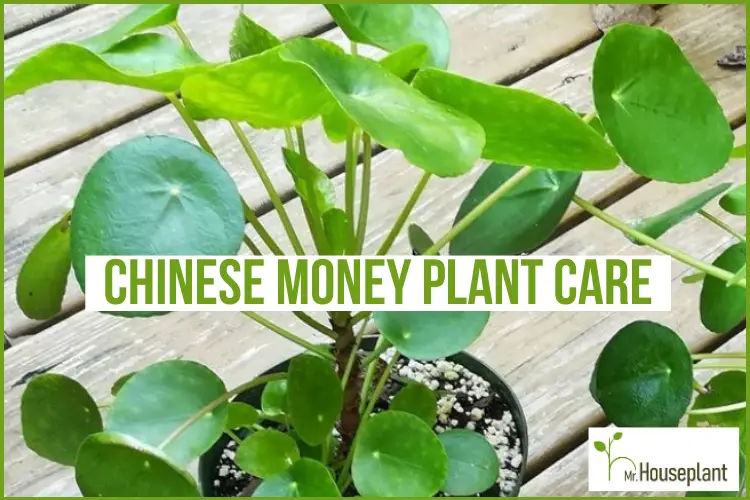
Having trouble with Chinese Money Plant care, or you bough one and don’t know what to do with it? You’re in the right place! This article will cover Pilea Peperomioides care in detail – from light, watering, and soil, to repotting, fertilizing, and propagation. Keep reading to learn all about this beautiful plant.
| Botanical Name (Latin Name/Scientific Name): | Pilea peperomioides |
| Common Name: | Chinese Money Plant |
| Light: | medium light (1,000 lux – 2,500+ lux) |
| Watering: | when the soil dries out to the bottom of the pot |
| Soil: | well-draining mix |
| Repotting: | once a year |
| Temperature: | 65°F to 75°F (18°C to 24°C) |
| Humidity: | 25% to 50%, but it adapts well to any humidity |
| Toxicity for Pets: | Non-Toxic |
| Toxicity for Humans: | Non-Toxic |
| Propagation: |
|
| Pruning: | Prune dead or diseased growth or when you want the plant to branch out |
Chinese Money Plant Care
Light Requirements
| Minimal amount of light: | 1,000 lux (100 FC) |
| Optimal amount of light: | 2,500+ lux (250+ FC) |
| Direct sun tolerance: | 3-4 hours |
| Category: | medium light |
Most of the problems with Pileas people experience are due to low light. Pilea plants like bright, indirect light, and even direct sun. However, like with any plant, direct sun can burn their leaves, so make sure to gradually adjust the plant to it. I keep a lot of my Pileas in direct sunlight — early morning, late afternoon, some even around 1 to 2 pm, when the sun is pretty strong, and they do great!
Water Needs
Wait for the soil to dry out completely before watering. If not sure, wait or check by putting a chopstick into the soil — if it comes out clean, it’s time to water. Pilea plants don’t like to be watered frequently. It’s better to leave them dry than to keep them wet. And it’s easy to notice when your Chinese Money Plant is really thirsty — it will get droopy when it needs to be watered. But you don’t want to always wait for this to happen as you could be slightly damaging the plant. If unsure when to water, water once, wait for the leaves to get droopy, write down how many days it took for this to happen, and the next time water 2 days earlier.
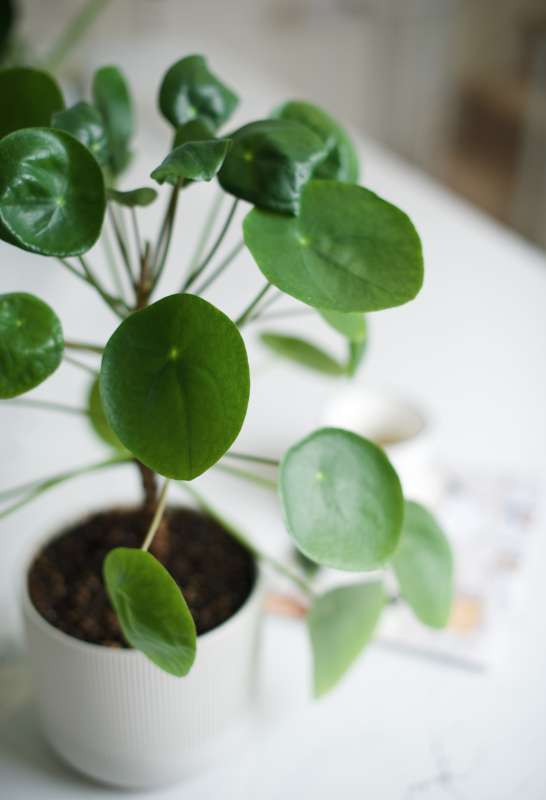
Chinese Money Plant care also means proper watering
If you overwater it, it will lead to root rot and the leaves will start to drop. Please note that leaves can drop for other reasons as well. It’s always important to look at the overall environment your plant is in and the care it’s getting before jumping to conclusions on why the leaves are dropping. Make note that the more light Chinese Money Plants enjoy, the more quickly their soil will dry out and you will need to water them more frequently. Terracotta pots will also help the soil dry out more quickly.
Humidity Needs
Recommended humidity levels for Chinese Money Plant are between 25% to 50% but this houseplant doesn’t care a lot about humidity. It adapts well to even lower humidity levels.
Temperature Requirements
Average indoor temperatures between 65°F to 75°F (18°C to 24°C) are great for Pilea plants.
Fertilizing
If you repot your Pilea Plant once a year, there won’t be a need for fertilizer, as fresh soil will provide the plant with needed nutrients. But if you would like to fertilize, that is fine. As long as the plant is actively growing, it is ok to fertilize. I recommend the Sill fertilizer. Whichever fertilizer you decide to use, always follow the instructions on the label on how to dilute it. Adding too much fertilizer can kill a plant!
Soil
Pilea plants prefer well-draining soil such as Mother Earth Soil that you can use straight out of the bag. Or if you like to build your own potting mix, you can use Proven Winners Potting Soil and mix 2 parts soil with 1 part perlite and 1 part bark.
One of the most important parts of Pilea Plant care is getting the soil right. Roots need oxygen to grow. They take oxygen and release carbon dioxide. In order for the roots to have oxygen, you have to use a good, porous potting mix that contains a lot of macropores. Macropores contain oxygen.
Repotting
Repot your Chinese Money Plants as soon as you see the roots coming out the bottom. If the roots become too root-bound or the soil becomes too compacted, they will stop or slow down growth.
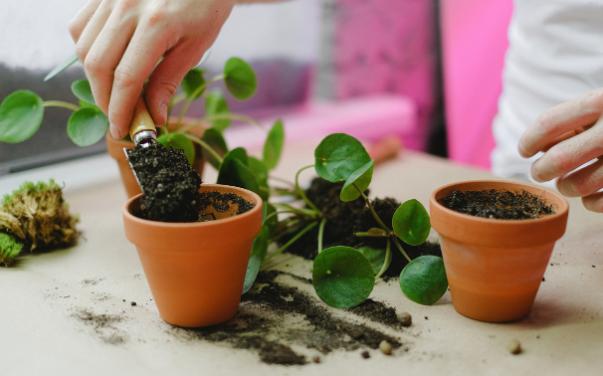
Adding soil mix to a new pot as one of the steps in repotting Pilea Plant
- Add soil to the new pot – I use a mix of any potting soil mixed with 30-50% perlite, to make the potting medium more porous and less water retaining. Plant roots need oxygen for best growth and perlite makes the mix airier and retains less water, so plants don’t stay wet as long. You can also use pumice, a porous volcanic rock, usually gray in color, instead of perlite. Using such an inorganic component that doesn’t decompose helps maintain the soil structure and prevents compaction. The more pumice you add, the more it will save air space and reduce the compaction of the substrate.
- Take the plant out of its old pot – Remove the old soil completely, inspect the roots, and if there are any that are soft, mushy, smelly, cut them off, they are rotting. Take a look at how I do it in the video below.
- Loosen the root ball – When loosening the root ball, don’t only loosen only the bottom of it, which is what I often see people doing, but also the sides. Press the root ball from all sides to break it up. This will enable all of the roots to continue growing freely into the new potting medium, not only the bottom ones.
- Put the Pilea Plant into the new pot and add more soil – I pot all of my indoor plants about one inch below the pot rim, so there is enough room to water. Press the soil firmly and water thoroughly after you’re done.
Toxicity To Humans
Pilea plants are non-toxic to humans according to California Poison Control System (CPCS). They also state that even plants that are not toxic can cause vomiting in humans, so make sure to keep the plant away from the children.
Toxicity To Pets
Chinese Money Plant is non-toxic to pets according to the American Society For The Prevention Of Cruelty To Animals (ASPCA). However, non-toxic plants also can cause vomiting in animals, as confirmed by the California Poison Control System (CPCS).
Pruning
You can prune your pilea to stimulate branching or to remove brown dead leaves. To prune for branching, use a sharp and sterilized pair of scissors or pruning shears and make a cut half an inch below the top of the stem. To remove brown dead leaves, prune at the end of the petiole, near the main stem.
Propagation
You can propagate Chinese Money plant in a few ways:
- By division – separating Pilea babies
- By top branch cuttings
- From single leaf/bud cuttings
Chinese Money Plants are very easy to propagate. Many people choose to gift new babies to their friends and maybe that’s why this houseplant is also called a Friendship Plant! :)
You can propagate your Friendship Plant any time of year to have more babies for yourself or to pass them to your friends. In winter, the process will be slower due to less natural light available, but if you get a grow light and a heat mat, you can propagate any time of year. The more light you provide, the more the cuttings will photosynthesize and the faster they will get the energy to root. Same thing goes for heat. A heat mat can increase the temperature of the propagation media by 5-10 degrees, which speeds up root formation.
Pileas produce new shoots all the time and you can easily propagate babies in soil or water. If you want to do leaf propagation, make sure to cut a piece of the trunk together with the petiole (with a dormant bud).
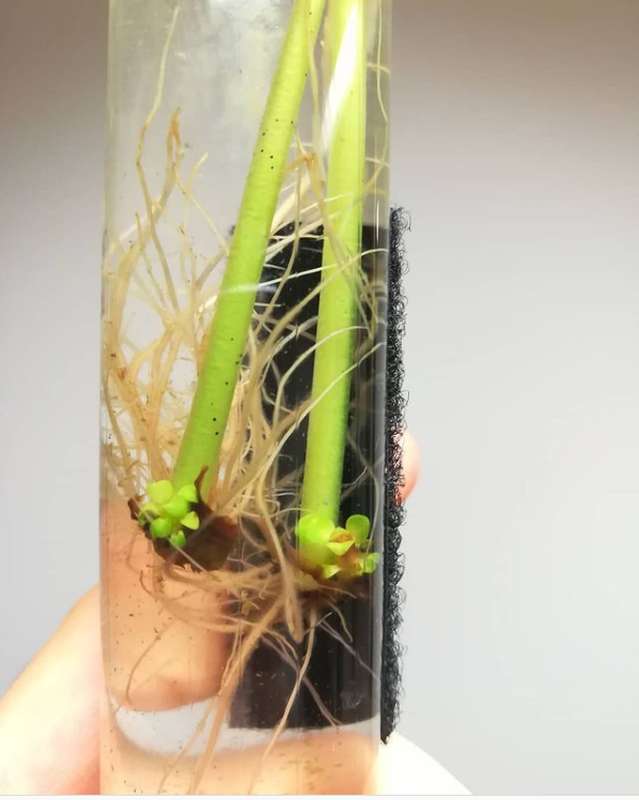
New Pilea babies on Mr. Houseplant's leaf propagated pilea peperomioides ♥️
My first attempt at Pilea Peperomioides leaf propagation was unsuccessful, as I didn’t realize at the time that you need to cut a tiny piece of the trunk as well, together with the petiole. Otherwise, the Pilea leaf grows only roots and no new leaves. In the video below, you can see what happens when you try propagating Pilea leaves with a petiole and what results you get with a Pilea leaf with a petiole AND a tiny piece of the main stem.
Below is another one of my propagation videos that resulted in new leaves, not only roots.
You can propagate the Chinese Money Plants in three ways:
1. By division – separating Pilea babies. If the babies are bigger and further away from the main mother stem, you can gently break them off with your hand but if they are smaller and their stems are short and close to the mother plant, I recommend cutting them using a knife, as close as possible to the mother stem. It will be easier to plant them if they have a longer stem. Take a sharp knife and select a healthy green leaf. You can propagate in soil or water, it doesn’t make a difference; use the method that works better for you. Below is my video demonstrating the separation process.
2. By top branch cuttings. Cut off the top of a Pilea plant or the top of any branch. When you cut the top off, you want to leave not more than 3 to 4 leaves on the plant. Place the cutting in water, in filtered/indirect bright light, and wait. Add water every couple of days because it will evaporate. Replace water once every 1 to 2 weeks, and be patient. You can also later cut off any of the new branches and propagate in the same way. Don’t be afraid to cut, you won’t hurt the mother plant. It will branch out just beneath the cut, so you will have a more lush mother plant.
3. From single leaf/bud cuttings. Cut off a leaf with a petiole and a tiny piece of the trunk with a node containing a dormant bud. You need a healthy leaf. If a leaf fell off your plant, in most cases there is something wrong with it, otherwise, it wouldn’t have fallen off. Even if a healthy leaf was physically knocked off, you need a tiny piece of the trunk that contains a dormant bud; otherwise, the leaf will grow roots and not new leaves.⠀
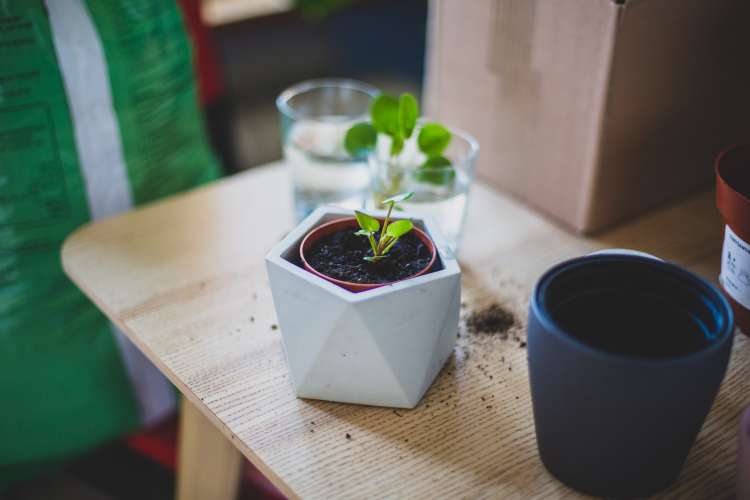
A young Pilea peperomioides getting its own home in a polygonal pot
How to propagate Pilea leaves/buds cuttings in water or soil?
I recommend placing Pilea cuttings in water, as your chances of success will be better. Especially if you have less experience with propagation. Here are the steps:
- Cut the leaf with its petiole (petiole is the long part connecting the leaf to the main trunk/stem) and a small piece of the trunk. Take multiple leaves to increase chances of success.
- Place the leaf in water or directly in the soil, in indirect bright light, the brighter — the better.
- If you’ve put them in water, be aware the water will evaporate and the leaf will use some of it, so refill occasionally. I refill my test tubes twice a week. Replace the water once in a while completely, when it gets dirty/green/ or develops algae. I replace it every 1 to 2 weeks.
- After about a month or two, you should have a Pilea baby big enough (1″-2″ of roots) to pot into the soil. If you’re doing soil propagation, you should see a new shoot coming out.
To enable faster propagation and increase your chances of success, make sure you provide your cuttings with enough:⠀
- Light – Don’t keep cuttings in dark corners but next to the brightest window. If you don’t have a lot of light, get a grow light. Light speeds up photosynthesis. Try to provide more than 5,000 lux of indirect light. If you can give the leaf a few hours of early morning direct sun, great! You will give it 30,000-100,000 lux of light during that time. And yes, you can try propagating a plant in a dark corner but it will take ages and you’re more likely to fail.⠀
- Oxygen – Roots use oxygen and release carbon dioxide. If you use an air pump in your propagation vessels, you can drastically reduce the propagation time. Try it! ⠀
- Warmth – If your propagation medium (water or soil) is warm, the propagation time can be cut in half. The optimal propagation temperature is between 24-26C (75F-79) for a lot of indoor plants. I also recommend using a heat mat.
- Water/Soil – Replace water weekly. If in soil, cover the plant with plastic, to reduce water loss through transpiration and maintain the humidity of around 80-90%. Water as soon as you notice the topsoil is dry.⠀
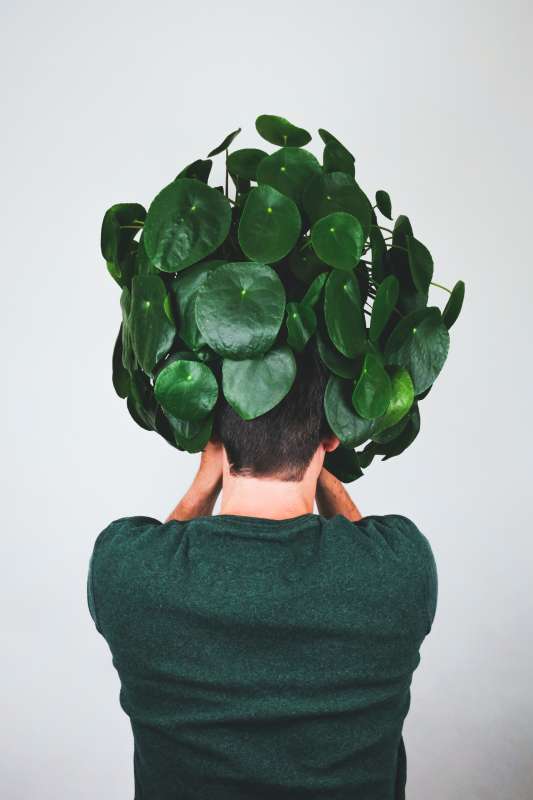
Chinese Money Plant
FAQs about Pilea Plant
My Chinese Money Plant is Not Overwatered and It Gets the Sunlight it Needs. Why Are the Leaves Droopy?
One of the reasons why the leaves on your Pilea Plant will get droopy is if it wasn’t watered for a while. While this houseplant doesn’t like to sit in water, it also doesn’t enjoy being bone dry for too long.
I had a Pilea that I let dry out completely, to the level that the leaves became droopy so I decided to water it and record how it behaves. Here’s an underwatered Pilea timelapse.
Why Are My Pilea Leaves Dropping?
There could be many reasons for why the leaves are dropping. If the soil is not porous enough and was overwatered, the roots could be dying from rot and that could be one reason for leaves to drop.
Pileas handle better staying on the dry side then on the wet side, but after a while they will start dropping leaves if kept underwatered for too long. After all, they are not a succulent. This could be another reason.
There could be other reasons as well, like pests and diseases.
If it’s only one or two leaves dropping, this is not something you should stress about. Some leaf loss is normal with all houseplants.
Why are my Chinese Money Plant leaves curling?
There are many different theories and a variety of possible reasons why the leaves on a Chinese Money Plant curl but I’m afraid there is no certain theory on why this is happening. Just know that it’s not something that is affecting the health of your plant. As long as the leaves are green, they look healthy and are not falling off, there is really no reason to worry about them curling.
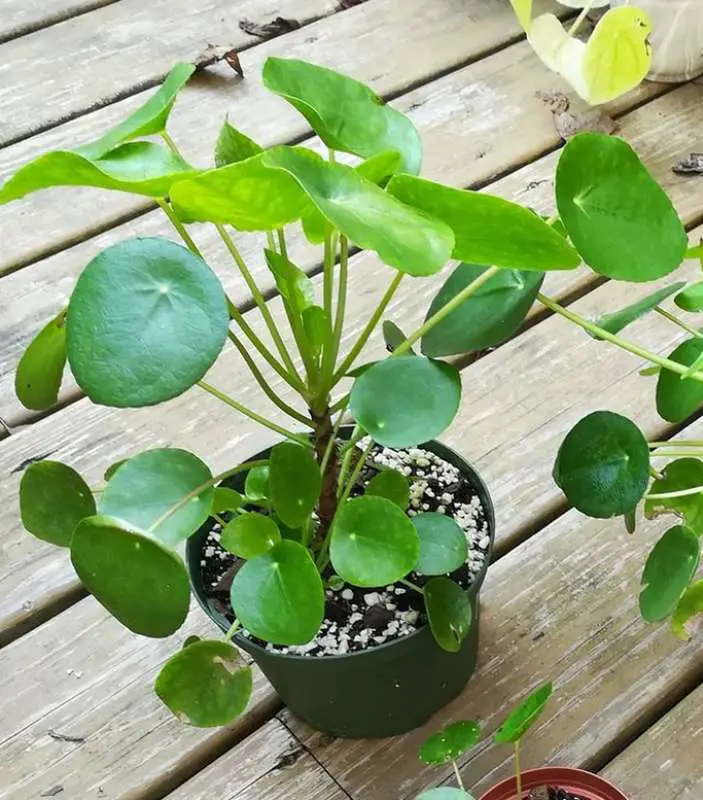
Pilea Peperomioides
My Money Plant Has Gotten Yellow Leaves, What Am I Doing Wrong?
One or two yellow leaves on your Pilea Plant is not something you should stress about. Some leaf loss is fine with all houseplants. As the plant grows new leaves, it might not have the energy to support all of the old leaves. So, it gets mobile nutrients from them, the leaves turn yellow, dry out and fall off. That’s ok.
A plant can only support a certain amount of leaves at any time and this amount is directly related to the amount of light the plant is getting. So, if you want to increase the number of leaves, increase the amount of light. But the first step would be to measure the light.
Some leaf loss is a normal part of the life cycle, not a reason to stress. Why would you worry if the rest of the plant is beautiful and lush?
However, if your plant is getting more and more yellow leaves, and this happens in a short amount of time, make sure it gets enough light (minimum of 1,500 lux, ideally more than 3,000 lux), don’t overwater it but also make sure it doesn’t stay dry for too long, and make sure it has enough nutrients (repot your plant if you haven’t in the last 12 months so it can get fresh nutrients).
But again, if your Money Plant has gotten just a few yellow leaves, and you know you’re taking good care of it, there is no reason to worry.
My Money Plant Was Exposed to Cold Air, What Can I Do?
If your money plant was exposed to cold air for too long, this will cause damage to the leaf tissue. Some leaves might turn dark, some might fall off, even the whole plant might look droopy. Depending on how cold the air was and how long the plant was exposed, it might be beyond saving. If not, take a look at this video to see how I recovered my pilea from the same situation.
Have More Questions about Pilea Plant Care?
If you’re having doubts or more questions regarding Pilea Plant care, please let me know in the comments below this article. You can also schedule a virtual one-on-one consultation with me and get the help you need.
Always happy to help!
Yours Truly,

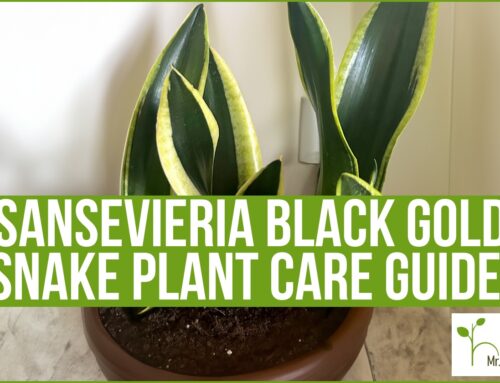



Hi I recently had to change the soil on my plant because I noticed small flies around it and now it is looking a bit droopy why is this please.
Hi Elizabeth, a lot of plants will be stressed after repotting and can look droopy. If you provide them with sufficient light and proper watering, they should recover in a few weeks 🙂